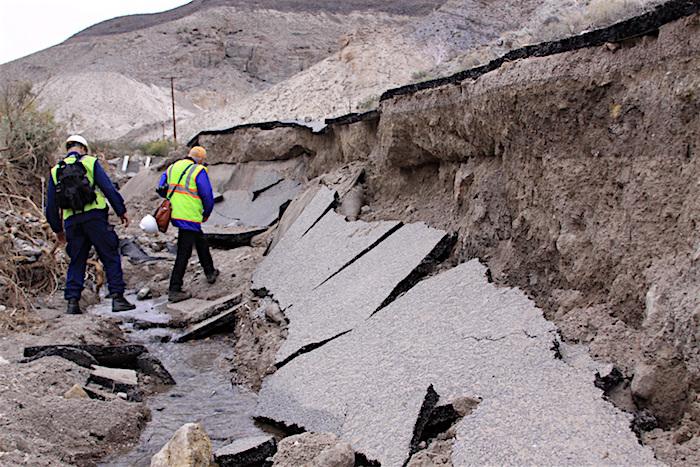
National Park Service personnel are pondering how best to rebuild the Bonnie Clare Road that leads to Scotty's Castle in Death Valley National Park/NPS
Scotty's Castle, the iconic, history rich mansion in Grapevine Canyon of Death Valley National Park, now is not expected to open before 2020 as National Park Service personnel take public comments on how they plan to rehabilitate the castle and rebuild the Bonnie Clare Road that leads to it.
The castle has been closed since a devastating flash flood in October 2015.
“Right after the flood we were focused on emergency clean up and stabilization,” explained Death Valley Superintendent Mike Reynolds. “Almost 200 people came over the first five months. They helped us reopen roads park-wide and dug mud out of buildings at Scotty’s Castle.”
Since then, the park-wide flood recovery effort has been divided into 39 projects, with a total estimated cost of $48 million. Some projects, such as most road repairs, have already been completed. The work at Scotty’s Castle is more complicated.
“Scotty’s Castle is a very special place,” said Superintendent Reynolds. “It has significant historic features, the surrounding area has sensitive wetlands, and is important to the Timbisha Shoshone. We don’t want to do more harm by not taking the time to consult on our proposals. Plus, federal laws require us to do that. These environmental assessments are a way for us to get important feedback from the public, tribes, historians, biologists and others.”
The Park Service and Federal Highway Administration are proposing to reconstruct 7.6 miles of Bonnie Clare Road (also known as Scotty’s Castle Road) from the Ubehebe Crater Road intersection to the park boundary at the California/Nevada state line. This section of road is currently closed to the public. This project would restore access to the park from Tonopah and Beatty via NV-267.
The Bonnie Clare Road Reconstruction Environmental Assessment evaluated two alternatives: a no action alternative and an alternative to reconstruct Bonnie Clare Road (the park’s preferred alternative). If the park’s preferred alternative is implemented, the reconstructed road would have two 10-foot-wide paved travel lanes, each with a 1-foot shoulder. The reconstructed road would generally follow the alignment of the pre-flood road, with some modifications as needed to elevate the road above the new flow line of Grapevine Canyon. Buried concrete Jersey barriers, riprap embankment protection, and some minor stream realignment and restoration also would occur to make the reconstructed road more resilient against future floods.

Most aspects of Scotty's Castle, including this historic Garage, need substantial rehabilitation in the wake of a October 2013 flash flood/NPS
The park proposes to rehabilitate various historic and non-historic features in the Death Valley Scotty Historic District (Scotty’s Castle). The Scotty’s Castle Flood Rehabilitation EA evaluated two alternatives: a no action alternative and an alternative to rehabilitate, repair, and replace facilities at Scotty’s Castle (the park’s preferred alternative).
The park’s preferred alternative would include repairs of historic buildings, including the Main House, Annex, Garage (Visitor Center), Long Shed, Bunkhouse, Hacienda, Fire Cache, and Chimes Tower.
A few changes are proposed for historic structures. Seismic stabilization would be added to the walls and roof of the Garage (Visitor Center). A fire suppression system would be added to the Garage, Long Shed, and Bunkhouse. Interpretive exhibits would be installed inside the Visitor Center. An existing alcove and doorway between the Garage and Longshed would be enlarged into a breezeway to improve flood resiliency and improve accessibility.
The Gas House would be rehabilitated by removing a wooden addition to improve visitor experience and restore the historic appearance of the building. A shade structure that is compatible with the original design of the Gas House and historic district would be installed on the western portion of the building. The Wishing Well would be rehabilitated.
The NPS also proposes to work on utilities at Scotty’s Castle that were heavily damaged by the flood. About 1 mile of water line would be replaced from the water source to Scotty’s Castle. Most of it would be placed under Bonnie Clare Road’s paved surface to protect it from future floods. The septic system and leach field would be reconstructed with new materials in the same general location they were located prior to being destroyed by the 2015 flood.
The water delivery system would be repaired by installing a new 900-square-foot Spring House, repairing the historic water tank, and constructing a new roof over the historic water tank. The aging and deteriorated internal water distribution lines within the historic district would be replaced.
The parking lot would be expanded and reconstructed to accommodate more parking, improve circulation and access, and improve drainage.
Flood control berms would be constructed to protect the water system and historic buildings from future within the main drainage of Grapevine Canyon.
More detailed information on both EAs is available online.
Superintendent Reynolds will host public meetings to discuss the EAs and flood recovery efforts so far. The public is encouraged to attend to ask questions and to share their opinions. Light refreshments will be available.
Monday, December 4 at 5 p.m.
Bob Ruud Community Center, Pahrump
Tuesday, December 5 at 6 p.m.
Beatty Community Center
Tuesday, December 12 at 5 p.m.
Furnace Creek Visitor Center, Death Valley
Public comments need to be received by December 22 to be considered.





